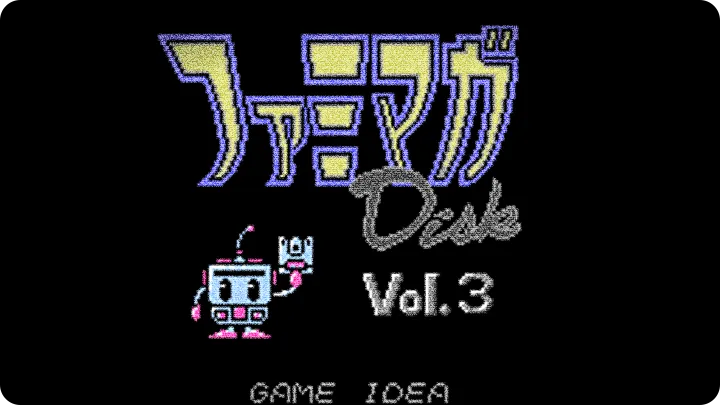 Quick fun fact before we shove another die off a cliff: this game comes from the Famimaga Disk line. These were disk magazine releases that let small teams, and even magazine staff, publish experimental titles directly to Famicom Disk System owners. In an age when a magazine could ship a playable program to your drive, All 1 feels right at home. It has the clever, oddball energy of a lab experiment that wandered into your living room.
Quick fun fact before we shove another die off a cliff: this game comes from the Famimaga Disk line. These were disk magazine releases that let small teams, and even magazine staff, publish experimental titles directly to Famicom Disk System owners. In an age when a magazine could ship a playable program to your drive, All 1 feels right at home. It has the clever, oddball energy of a lab experiment that wandered into your living room.
 I love that. It explains the charm and the stubbornness. Controller in hand: we guide a ladybug that pushes dice. Each push rolls the die and changes the face. The goal is simple — make every die show a one. The screen splits between a scaled map on the right and an enlarged view on the left. A front-view window even helps track which face is where. This is more a puzzle of spatial reasoning than a test of reflexes.
I love that. It explains the charm and the stubbornness. Controller in hand: we guide a ladybug that pushes dice. Each push rolls the die and changes the face. The goal is simple — make every die show a one. The screen splits between a scaled map on the right and an enlarged view on the left. A front-view window even helps track which face is where. This is more a puzzle of spatial reasoning than a test of reflexes.
 Gameplay highlights appear instantly. Push a die, it rolls, its number changes — the mechanic is elegantly simple. Rocks, flower beds, and tight corridors force careful planning. You must think several moves ahead. With top and front perspectives shown together, that extra window is often vital. It tells you which face will land on top after a sequence of rolls.
Gameplay highlights appear instantly. Push a die, it rolls, its number changes — the mechanic is elegantly simple. Rocks, flower beds, and tight corridors force careful planning. You must think several moves ahead. With top and front perspectives shown together, that extra window is often vital. It tells you which face will land on top after a sequence of rolls.

 It rewards planning. Some levels feel like little mathematical proofs — set a chain of rolls and watch everything fall into place. Nudging a cube and seeing numbers flip is oddly addictive. I smile when a long sequence resolves and the stage clears.
It rewards planning. Some levels feel like little mathematical proofs — set a chain of rolls and watch everything fall into place. Nudging a cube and seeing numbers flip is oddly addictive. I smile when a long sequence resolves and the stage clears.
 Be candid with me: what are the rough edges? The game can be merciless. Many stages have only one narrow solution; one mistake and you often must restart the level. There is no hand-holding, no hint system, and sometimes the layout hides the only viable route behind what looks like an obvious dead end. For players who enjoy trial-and-error, that is fine — for others, it is frustrating. Also, the controls are deliberately basic: the ladybug pushes but cannot pull, and a single wrong push can strand a die against a rock.
Be candid with me: what are the rough edges? The game can be merciless. Many stages have only one narrow solution; one mistake and you often must restart the level. There is no hand-holding, no hint system, and sometimes the layout hides the only viable route behind what looks like an obvious dead end. For players who enjoy trial-and-error, that is fine — for others, it is frustrating. Also, the controls are deliberately basic: the ladybug pushes but cannot pull, and a single wrong push can strand a die against a rock.
 We should file a few hot tips while this is fresh. These are the tricks I use when I know I’m about to throw the controller in a drawer:
We should file a few hot tips while this is fresh. These are the tricks I use when I know I’m about to throw the controller in a drawer:

- Always check the front-view window before committing to a push in a narrow corridor — the top face you see in the enlarged map can be deceptive.
- When several dice are clustered, try to plan rolls that change numbers beneficially for multiple dice in sequence; sometimes you can cycle two dice into ones with three pushes.
- Avoid the flower garden unless you have no choice: it’s a no-roll zone and locking a die there usually means restart.
- If a stage looks like it has one path, experiment at the start: a minor detour early can open a chain that clears the rest, even if it seems counterintuitive.
 Memorable moments? There was that stage three evenings ago when we had a perfect row of five dice and a rock in the middle. I spent fifteen minutes rearranging them so that one well-timed push would turn three dice to ones and leave the two others fixable. When it finally happened, that little chime and the screen flipping felt like a boss fight victory.
Memorable moments? There was that stage three evenings ago when we had a perfect row of five dice and a rock in the middle. I spent fifteen minutes rearranging them so that one well-timed push would turn three dice to ones and leave the two others fixable. When it finally happened, that little chime and the screen flipping felt like a boss fight victory.
 Speaking of boss fights — the “final boss” is essentially the last, most constrained puzzle. It is designed like a mechanical puzzle box: dice arranged in a tight maze with flower beds forming chokes and only one route to transfer rolls without trapping any die. We made one wrong push and the level became unsalvageable. It took patience and a perfect sequence of rolls; when we finally cleared it, the relief was tangible. It is not a dramatic cinematic, but the sense of accomplishment is the reward.
Speaking of boss fights — the “final boss” is essentially the last, most constrained puzzle. It is designed like a mechanical puzzle box: dice arranged in a tight maze with flower beds forming chokes and only one route to transfer rolls without trapping any die. We made one wrong push and the level became unsalvageable. It took patience and a perfect sequence of rolls; when we finally cleared it, the relief was tangible. It is not a dramatic cinematic, but the sense of accomplishment is the reward.
 Anecdote time: I remember reading in Famimaga that readers loved swapping solutions by mail. I can imagine gamers scribbling step-by-step moves on scratch paper and passing them to friends at the arcade or schoolyard. In our present play session, that impulse is alive — sometimes you need a partner to read the front view while you handle the top-down moves.
Anecdote time: I remember reading in Famimaga that readers loved swapping solutions by mail. I can imagine gamers scribbling step-by-step moves on scratch paper and passing them to friends at the arcade or schoolyard. In our present play session, that impulse is alive — sometimes you need a partner to read the front view while you handle the top-down moves.
 If you want to enjoy All 1, approach it as a brain-teaser package rather than an action game. Its strengths are originality and the purity of the puzzle concept. Its deficits are a lack of hints, very punishing single-solution stages, and a presentation that will feel austere compared with larger commercial releases.
If you want to enjoy All 1, approach it as a brain-teaser package rather than an action game. Its strengths are originality and the purity of the puzzle concept. Its deficits are a lack of hints, very punishing single-solution stages, and a presentation that will feel austere compared with larger commercial releases.
 Final hot tip before another stage: keep notes. Pencil the sequence—UP, PUSH, RIGHT—in the margin of your manual or a sticky note. This is a game that rewards meticulous planning and patient execution more than lightning reflexes.
Final hot tip before another stage: keep notes. Pencil the sequence—UP, PUSH, RIGHT—in the margin of your manual or a sticky note. This is a game that rewards meticulous planning and patient execution more than lightning reflexes.
 No flashy endings here, but a satisfying mental workout. For players who love methodical puzzles and enjoy the satisfaction of a perfectly executed sequence, All 1 is a hidden gem from the disk-mag era. For those who prefer more forgiving or explanation-rich puzzles, it will test your temper. Either way, it is a distinct piece of Famicom Disk history that deserves a seat at the table when we talk about inventive puzzle design.
No flashy endings here, but a satisfying mental workout. For players who love methodical puzzles and enjoy the satisfaction of a perfectly executed sequence, All 1 is a hidden gem from the disk-mag era. For those who prefer more forgiving or explanation-rich puzzles, it will test your temper. Either way, it is a distinct piece of Famicom Disk history that deserves a seat at the table when we talk about inventive puzzle design.
